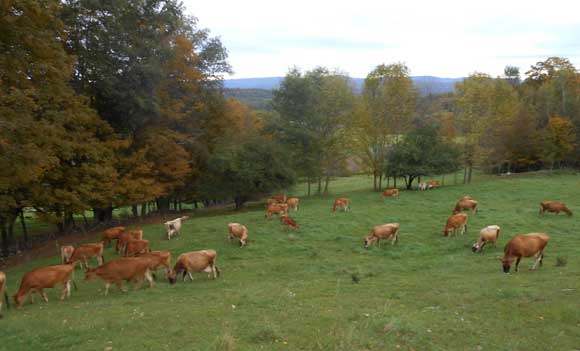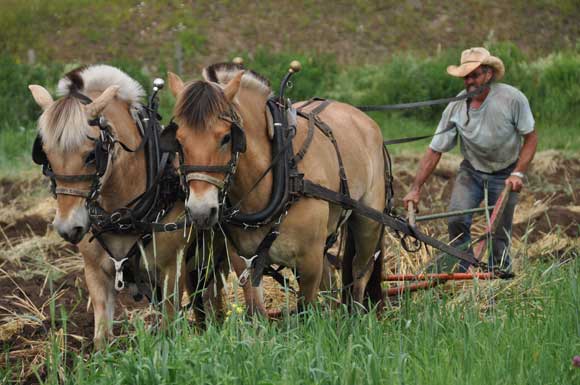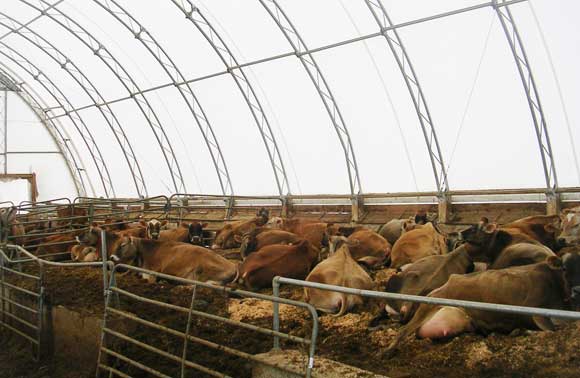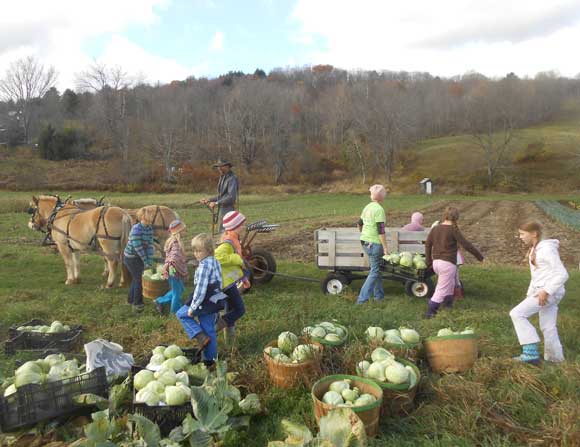Horse Powered Market Gardening Economics
Case Study: Cedar Mountain Farm

In addition to ourselves, our farm business has three employees — one who works year-round primarily at milking and barn chores, and two who are engaged seasonally in the full spectrum of cattle chores and garden. We offer our workers a starting pay of $8.00/ hour — plus milk and meat and veggies. We have onsite housing for two workers. We also pay FICA, farm insurance, and workman's compensation. We wish we could offer more, but as it is, we are often paying our employees more than we pay ourselves.

In 2010, we had a total of $91,000 in dairy sales. This figure is coupled
with a total of $36,000 in produce sales through the CSA, farmer's market,
farm stand, and wholesale, and an additional $30,000 for catering, beef,
and resale of retail produce at our farm stand. Our combined household income
was $20,000 (we obviously have a lot of overhead expenses). Of course, income
estimates for the farmers don’t include a tally of all the food we produced
for our own household.
Currently we maintain four horses ranging in ages from 4 to 17. In actuality,
we only require the work force of a team to execute the tasks in the market
garden and the hay fields. During spring and fall field work it would be easier
on our Fjords to fold in a third horse for bigger jobs of plowing, discing or
spreading. I am currently grooming our youngest horse to eventually play that
role. I also like to imagine a time when we might be ambitious enough to purchase
a motorized forecart (or one of the new 24HP ground driven models) and employ
four horses to pull a hay baler, haybine, and perhaps a tow-behind combine. For
the moment, however, four horses on our farm must be accounted as symptomatic of
our passion for horses and in abeyance of our Yankee pragmatism.
We purchased two mares as weanlings and our gelding as a 2-year old. We chose
to take on the lower initial price and incremental costs of raising and training
young horses instead of the up-front costs of purchasing mature and trained horses.
Also, young horses allowed us to acquire Fjords, which were enjoying a peak of
popularity in the mid-90s, with mature mares fetching anywhere from $10,000 to
$16,000. Our third mare was born on this farm. We paid a total of $15,000 for
the four horses (this includes $3,500 in costs to produce the foal born on the
farm). We might add that the likelihood of finding mature and trained workhorses
in our region is not a given.
| Farm Products | vegetables (2 acres), dairy, meat |
| Markets | CSA, farm stand, farmers market, cheese maker |
| Power Sources | 4 horses ($8,500), tractor |
| Gross Income | $177,000 |
| Net Income | $ 20,000 |
| Grain | $842 |
| Hay | $780 |
| Bedding | $442 |
| Stable Repairs | $200 |
| Veterinary | $200 |
| Supplies | $200 |
| Electricity | $200 |
| Vaccinations | $116 |
| Trucking | $100 |
| Fencing | $100 |
| Harness Parts/Repairs | $100 |
| Dewormer | $ 96 |
| Minerals/Supplements | $ 96 |
| Fly Repellent/Control | $ 67 |
| Baler Twine | $ 30 |
| TOTAL | $3,569 |
| Vegetable Production | 113 |
| Training/Exercise | 16 |
| Harnessing | 98 |
| TOTAL | 247 |
| Daily Chores | 213 |
| Clean Stalls/Dry Lot | 152 |
| Trim Hooves | 28 |
| Feed Production | 22 |
| Fence Moving/Repair | 8 |
| Health Care | 2 |
| TOTAL | 425 |
We house our horses in a three-sided shed. The structure they occupy is the
back side of a small barn. Their allotted space measures 12 feet wide by 45
feet long. Since our horses are limited to two to five hours grazing per day, they
spend a lot of time in and around this shed year round. In the summer both ends
can remain open to catch the breeze. We maintain the yard daily by raking up all
the droppings. The droppings are also removed from inside the shed, and an
equivalent amount of wood shavings are added every day (about a wheelbarrow
full). This task takes about 25 minutes. The horses are fed hay three to four
times a day in winter and twice a day in summer. They are each fed two pounds
total of supplemental grain twice a day. They have a water tank which is re-filled
and scrubbed out regularly. Moving fence for the horses during grazing
season probably adds up to about two hours of work each week. Most of the
time, we are able to set up paddocks that allow the horses to go out and return
without being led, but occasionally they must be taken out on leads. In sum, we
probably have an average of one hour of daily horse maintenance chores.
I have plans to build two tie-stalls so that I can have a place to park the team for
the lunch hour on days when they are required for a full day’s work. Right now, I end
up having to harness and unharness twice on such days. I have also been advised that
if they work in the woods in the winter, a tie-stall and blankets on their backs are
a good way to allow them to cool down without catching a chill.
We trim our horses’ feet and have always kept them barefoot. The one exclusively
barefoot trimmer we know of in our locale charges $45 per horse for a trim. With
shorter intervals for barefoot maintenance, the horses are getting trimmed seven
or eight times a year. Even though it takes me longer to trim than it would a
professional, I’d still have to be there to assist the farrier, so I figure we
are saving a small bundle by taking on the trimming.

If each horse is trimmed seven times a year, and one hour is spent on each trimming,
four horses multiplied by seven trims comes to 28 hours. Twenty eight trims at $45 a
trim totals $1,260 saved each year in farrier costs.
Our horses see the veterinarian regularly for updates on rabies shots and for
getting teeth floated. We do all immunization shots ourselves (under supervision
of our vet). They are wormed in the spring and the fall.
I tracked all my time and functions with the horses for 2010 and 2011 in the same
way I did for 2006 on the calendar in the barn. My hours have increased from 2006
to 2010 — a happy result for me. My hours for 2011 were almost the same as the previous
year — the only difference being that they were a little less midsummer due to a labor
shortage issue on the farm, but we made up the difference by doing field work late into
the fall, thanks to an especially mild season.
My recorded times don’t include grooming, harnessing, and hitching, or their reverse
at the end of the session. I like to keep routines as consistent as possible with the
horses, so I always brush them down and pick out their feet before doing anything else.
I look at it as an important transition time for the horses to begin to put their heads
into the work. I estimate that it takes me about 25 minutes to halter, pick feet, groom,
harness, and hitch a team of horses — and about 15 minutes to do the reverse — for a
total of 40 minutes. I would probably shave 10 minutes off this time for a single horse.
I believe I could do this task more quickly but don’t for a couple of reasons. Firstly,
I am getting a little pokey in my middle-age. Secondly, even when I am feeling the urgency
of the task at hand, I like to try and maintain a calm, measured routine with the horses.
Once at work in harness, our horses spend very little time idle. I take a very simple approach
to field work. The horses are employed for very basic tasks of tillage and cultivation, and
we usually go out and complete a job and then come back and either unhitch for the day or
move right on to the next implement. For the most part, the only time the horses are standing
is when waiting for me to load the spreader. We harvest into crates stacked in a garden-way
cart or onto a small trailer pulled by the team off the forecart. For big actions like harvesting
winter squash, we use a flatbed wagon hooked to the tractor. This is an area where we could
challenge ourselves to get the horses involved.

Mowing is another function in the market garden that we are still doing with a
5-foot bush hog on a 30 hp tractor. We use this mower to clip cover crops and to knock
down residue of crops such as brassica or corn for easier incorporation. Actually in
2011, I brought the dairy cows in to eat the corn stover and dealt with the brassica
by discing it with the horses. I have seen mowers of this type with a self-mounted motor
on top that can be towed behind a forecart and have this item on our new equipment wish
list. It remains to be seen how our horses would adapt to pulling a motorized implement.
I have tried knocking this kind of stuff down with scythe and machete but found it too
human labor intensive. This coming season I intend to use our recently restored No. 6
mowing machine with the shoes set high, but I will have to do a thorough job of rock
picking this spring. It was such a labor of love to bring that mower into working condition
that I still shudder at the thought of using it in the stony garden.
For a farm with multiple income streams like ours, the tracking picture can get a little
murky. Most of the work the horses currently do is in the garden, but the hay-making that
they are involved with also brings in forage for the cows. The flex harrow is used for seed
bed preparation and for dragging pastures where cattle graze. The spreader is used in the
garden and on the hay fields. In my tracking of hours I have not noted the distinctions.
I have also been recording training and exercise times for the horses. I see this as part
of my work with them. I am currently training two younger horses, and I also take my settled
team out driving in the off-months to help keep them in shape and in the mental mode of the
work horse.
We envision offering a dignified retirement to our horses as they age. I know that in harder
times people have had to make harsh choices between feeding kids and keeping a worn-out
workhorse companion on the farm. And even now, other folks might simply take a more
pragmatic view.
I think the “why” of using work horses is a great springboard for discussion.
From an economic and time standpoint (issues of environmental footprint set aside), my
assumption has been that our market garden would be more efficiently managed with a 30hp
tractor for primary tillage and spreading, and a lightweight cultivating tractor — but
I’d be happy if real numbers proved me wrong. We make our entire living from our
farm income. We have made working with horses work for us, we love being able to work
with them to get real jobs done on the farm, and we believe it is better for the planet
that we work in this way. From the holistic goal point-of-view, horses fit well into our
larger vision of trying to farm sustainably and in a way that is humanly enjoyable. We
are most certainly a hybrid horse and tractor powered farm. With every passing season
we have taken new strides in replacing the tractor by integrating horse power deeper
into our farming system.
| Basic Forecart | $800 |
| Hillside 9-inch single-horse plow | no cost |
| Pioneer 14-inch walking plow | $400 |
| Syracuse 10-inch two-way riding plow | $350 |
| 6-foot disc | no cost |
| 3-foot spring-tooth harrow (9 teeth) | $ 50 |
| 5-foot flex harrow | $250 |
| 5-foot spike-tooth harrow | no cost |
| 60-bushel John Deere manure spreader | no cost |
| 2 International walk-behind cultivators | no cost |
| McCormick straddle row cultivator | no cost |
| McCormick straddle row cultivator | $ 75 |
| McCormick No. 6 mower | $350 |
| Hoover single row potato digger | $ 50 |
| Harvest wagon | $500 |
| Flatbed hay wagon | $2,500 |
| I&J three-point hitch adapter | $250 |
| Toolbar to fit on three-point hitch adapter | $@50 |
| Grimm tedder | $1,000 |
| New Holland hay rake | $2,500 |
| 8-foot drop box lime spreader | no cost |
| TOTAL | $9,575* |
|
*Equipment costs do not include the expense of hauling and restoring implements, replacement parts, tongues, eveners, neck yokes etc. |
For me, the value of this study is that it has shown me that
our use of work horses to accomplish primary tillage, spreading, cultivation,
etc., is actually quite time efficient. The work hours represent a
very small fraction of the total human hours spent in the market garden and
yet the “big actions” that require “horse power” are
all accomplished in that relatively short time frame. It also underlines my
instinct that moving horses into haymaking and woodlot management will
be good for the horses (keeping them fit and engaged) and good for our
investment in having them on the farm (getting more for the cost
of their upkeep and “fuel”). We also record our tractor hours,
and I learned that farm workers at Cedar Mountain use the tractor two and
one-half times as much as we use the horses. This picture would look very
different if we weren't also a dairy farm, as most of these tractor hours
are for barn pack maintenance and cleaning, and manure and compost management.
Another piece of our operation into which I gained insight is that, by tracking
my hours and the implements I use with the horses, I discovered my
essential horsedrawn tool list boiled down to a dozen or so implements
to manage the market garden. I think it is not unusual for contemporary market
gardens to have 30 or more implements. For me, this was another indicator of
the efficiency of our approach. It is primitive farming, but it is working.
![]()
Stephen Leslie, along with his wife, Kerry Gawalt, and daughter,
Maeve, manages Cedar Mountain Farm, a 4-acre Fjord Horse-powered
CSA and Jersey cow dairy, located at Cobb Hill Co-Housing in Hartland,
VT. Stephen is the author of
The New Horse-Powered Farm and
Horse-Powered Farming for the 21st Century from Chelsea Green.
This article appeared in the
February/March 2015 issue of
Rural Heritage magazine.
